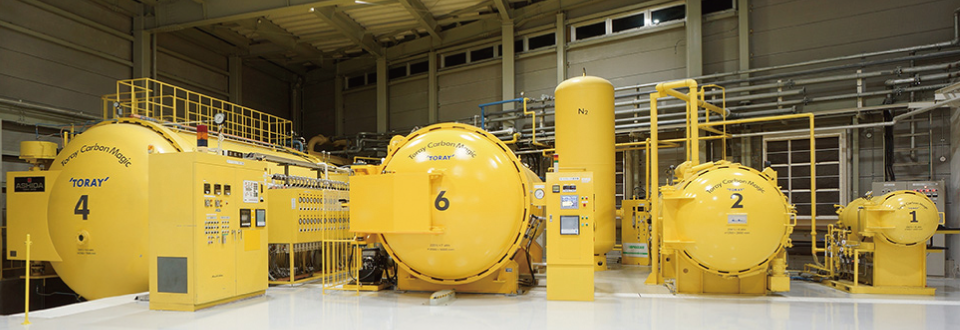
Graphiteleader SILVERADO
| Lenght (m) |
Power | Action | Weight (g) |
Close (cm) |
Top Dia (mm) |
Section (pcs.) |
Lure (g) |
Line PE(号) |
|
|---|---|---|---|---|---|---|---|---|---|
| 2.24 | ML | Fast | 84 | 114.5 | 1.3 | 2 | 3-15 | 0.4-1.0 |
| Lenght (m) |
Power | Action | Weight (g) |
Close (cm) |
Top Dia (mm) |
Section (pcs.) |
Lure (g) |
Line PE(号) |
|
|---|---|---|---|---|---|---|---|---|---|
| 2.34 | M | Fast | 88 | 120 | 1.4 | 2 | 5-20 | 0.6-1.2 |
Blanks Materials
More sticky blanks, lighter operability, more resonant and high sensitivity characteristics. It is the leader of graphite leaders to provide the best blanks for the actual fishing performance required.

By weaving carbon fibers that are crossed and arranged in the direction of 45 degrees, it is molded into a wall thickness while improving the uniformity and direction of the laminated density than the fabric, and it demonstrates even better characteristics for bending, twisting, and compression. As a result, the blanks's return (shape resilience) is fast, so the energy loss is minimized, and the feeling of playing, good swinging, flight distance, and accuracy were realized.
■Products adopted: Fishing rods and golf shafts

This 4-axis assembly fabric is an Olympic's own special 4-axis assembly cloth, and by tilting the angle of the diagonally arranged fibers to 63.4° and ass it more densely, it is possible to create a light and rigid blank. . With a multi-axis structure combined with other 4-axis fabric and plain weave carbon, you can achieve even more high-performance blanks performance.
■Products adopted: Fishing rod

SUPER QUATTRO GRAPHITE CLOTH LV IS THE LIGHTEST 4-AXIS BUBLES. Succeeded in reducing the weight of 23% without compromising the kinetic energy effect of 0°90°45° fiber. It is effective for those that require more tighter and lighter weight and for use in narrow diameters.
■Products adopted: Fishing rod

"Super Quattro Graphite Cross" has a structure that wraps fibers at a precise fine pitch and highly elasticizes fibers in each direction, and greatly improves its athletic performance.
■Products adopted: Fishing rods and golf shafts

It increases the elasticity of graphite fibers more than graphite cloth, making it even lighter. It is a high-grade fabric that greatly contributes to weight reduction while maintaining excellent mechanical properties that increase the layout to the lightweight shaft and is also a characteristic of the cross substrate. Medium-elastic carbon fibers woven vertically and horizontally create high rigidity in all directions and push the potential of the shaft up a notch.
■Products adopted: Golf shaft

The only weakness of graphite cloths that create a feeling that can not be done with unidirectional fibers alone was weight. However, when considering the layout that combines a balancer, an outstanding feeling was born. By changing the angle to the blanks, the balance of twisting and crushing rigidity has been adjusted so that the optimal feeling is created.
■Products adopted: Fishing rods and golf shafts

The difference from graphite cloth is the weight and molding thickness. It is a thin fabric composed of about 10% lighter fiber composition ratio of vertical and horizontal. The silhouette of the appearance is also different from graphite cloth, and the square, which is also a characteristic of the carbon pattern, is greatly projected, and it also has a visual impact of being light but strong.
■Products adopted: Fishing rods and golf shafts

Lightweight graphite cloth is the lightest super fabric among textiles. While keeping the feeling of graphite cloths, the freedom of layout increases and brings a new feel.
■Products adopted: Fishing rod

Composite fabric of Kevlar fiber and carbon fiber with high strength and impact resistance. It boasts outstanding strength and feeling that it could not be done by carbon alone. By involving the blanks with a bias cut, it has demonstrated a more multi-axis effect, and the strength of the twisting and crushing direction, and the follow-up performance of the blanks have been improved.
■Products adopted: Fishing rod

Kevlar®'s strength and elastic modulus are super fibers that have intermediate properties between carbon fiber and fiberglass, and is particularly tough. By weaving fibers, we have adopted a two-axis fabric that has been devised to relieve impact, and the balance of rigidity and vibration absorption energy has greatly contributed to improving shaft performance.
■Products adopted: Golf shaft

Hybrid boron, which is arranged equally spaced with boron fibers in a aligned carbon fiber, creates a metallic feeling that carbon fiber alone cannot produce. Boron fiber with a tensile elasticity of 40 tons not only exudes an exquisite feeling, but also dramatically improves the athletic performance of the shaft.
■Products adopted: Golf shaft
Pursuit of high-quality materials
We looked back at the material of carbon prepreg itself and focused on the resin, another material that makes up carbon fiber and prepreg. Therefore, by using a high-performance prepreg (carbon fiber resin impregnation sheet) that combines "Treca® T1100G" and "Nanoalloy® Technology Application Matrix Resin", we achieved a significant increase in bending elastic content while maintaining toughness. In addition, the use of the most advanced carbon fiber "Treca® M40X" with high elasticity has created a higher elastic rod shaft.

TRECA® M40X
The Treca® M40X, which pursued both fiber strength and modulus, has improved its strength by about 30% while maintaining the same modulus as conventional 40t carbon fiber.

TRECA® T1100G
Toray Carbon Fiber "Tre® T1100G", which achieves both high strength and high elasticity, is the highest strength 33t carbon fiber developed for next generation aerospace.

TRECA® T700G
The fiber characteristics are slightly more elastic than the T700S, and by combining with nanoalloy resin, the basic performance is raised a notch higher than the conventional product.
Innovative microstructure control technology "Nanoalloy®"

Nanoalloy® Technology
Toray Co., Ltd.'s "Nanoalloy® Technology" is an innovative technology that has realized the effect of improving the elastic modulus while maintaining the resilience of resin, which was a conflicting and difficult to balance.
* "Treka®" and "Nanoalloy®" are registered trademarks of Toray Co., Ltd.

Technology Inc.

Olympic Sensitive System
The good or bad of the "sensitivity" of the rod was to be understood after actually making the rod. Also, the way of feeling varies depending on the angler, and the method of evaluation was not established. We have made a number of prototypes, sensitivity measurements, and actual fishing to "quantify the sensitivity". And finally succeeded in quantifying the "sensitivity". O.S.S." The OLYMPIC Sensitivity System was born.
This system makes it possible to provide rods that clear the numerical values standardized under the same conditions. The experiment is conducted on the target fish of each rod, but here we will introduce the experiment of the rockfish rod Finezza.
◆Human hands can detect frequencies.
The Meisner and Pacini bodies under the human skin can detect the frequency (vibration). And these receptors are especially concentrated on the fingertips. There are test results that when the human frequency identification ability was tested from 15Hz to 120Hz, it was possible to identify in the range of ±20% in all frequency regions. With this report, experiments can be conducted based on the fact that the sensitivity of the rod can be detected by humans as a frequency.
※The number and reactions of each small body vary greatly from person to person.
There are two types of atari of mebaru.
We first decided to measure the actual atari of the rockfish. In this experiment, there are a total of 5 rods made by other companies, two other companies, GOFS-762UL-S (Prototype stage), GOFS-762UL-T G+ (a large number of guides) <Prototype stage>, GOFS-762UL-T G- (less number of guides) <Prototype stage> I installed a sensor terminal on the book rod and decided to display the frequency of Atari on the computer using FFTanalyzer (fast Fourier conversion) and MeasuringAmp (accelerometer). A 1.4g jig head is used for a 3lb fluoroline for the tackle. Then, in this experiment, I was able to confirm 8 ataris and a total of 40 ataris on each rod, and I was able to divide it into two major patterns. The first is the "intake/inverting type" of the graph of 1 or the "tracking/tucking type" of the second is 2. Since there is a difference in waveform, you can see that a different frequency is occurring.
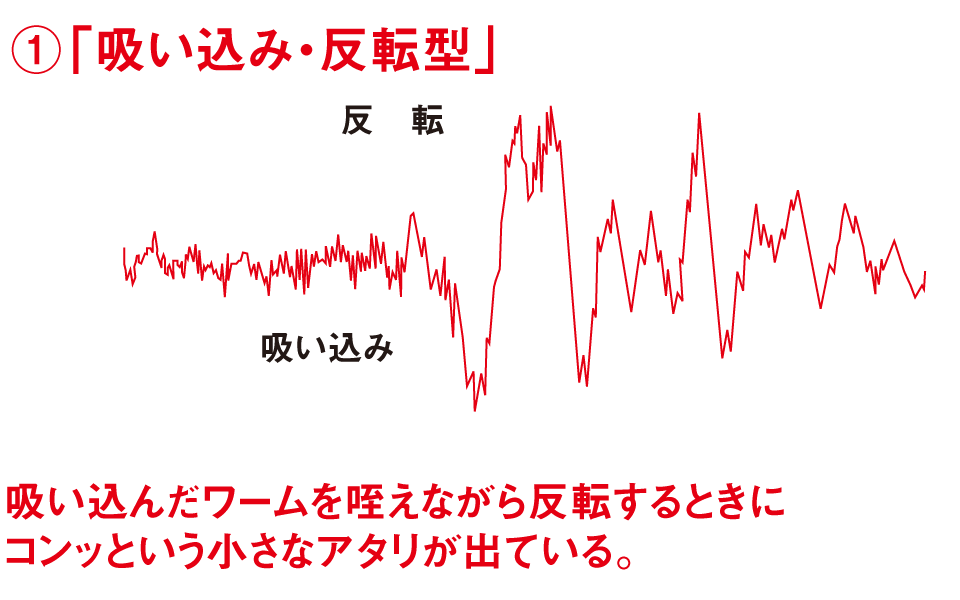
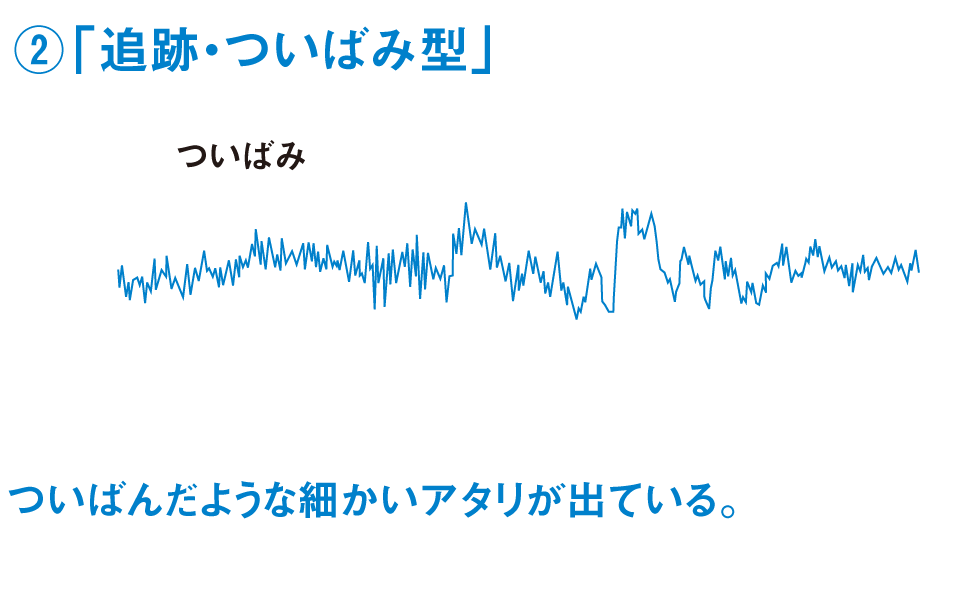
◆Frequency of each Atari
As a result of calculating the frequency of Atari transmitted to the rod from the aforementioned vibration acceleration graph, the main "take-inversion type" is a frequency of 6 to 18 Hz, and the trajectory of Atari is expressed only once in the tubular rod of Company A, representing the trajectory of the short bytes. I was there. For this reason, it is important to be able to automatically with a soft tip, rather than feeling Atari and multiplying it with awase for such a very small atari with low frequencies. It turns out that the other "tracking and peck type" has a frequency range of 30 to 40 Hz. Since there is a clear difference in the graph in this area depending on the rod, it can be said that the condition of the high-sensitivity rod is how you can feel the atari in this area.
◆The difference in the inherent frequency is the difference in how it feels
The object vibrates at a fixed frequency when it is impacted. This is called the inherent frequency. In general, it is said that the harder the higher the frequency, and the softer the higher the frequency. And of course, there is also a natural frequency in the fishing rod, and the one that measured it is Table 3. It shows the average of 64 times when the 3lb fluoroline is attached to the Omori No. 2 and played with the thread with your fingers. If you look at this, it can be said that only the rod of Company B is a rod with a unique frequency biased to the low frequency region. It is thought that the difference in the inherent frequency of each rod is one of the reasons why Atari feels different.

◆It is a resonant state that Atari becomes clear.
There is a phenomenon called "resonance". Resonance" can be said to mean that when the natural frequency and the number of vibrations given from the outside match, the amplitude is the greatest, that is, if the frequency of Atari is equal to the natural frequency of the rod, it becomes a resonant state and you feel "high sensitivity". If you compare the frequencies of the two Ataris and the 3 proper frequency graphs, Company B's rods are difficult to sense the "tracking and peck type" Atari, and Finnetzer has its own action on both the tubular top and the solid top. As a result, you can see that it is perceived against both Atari. In particular, you can clearly see the difference in Atari at 30 to 40 Hz of "tracking and stinging type" which is different in sensitivity. As a result, even if it is a solid top, it can be said that it can achieve high sensitivity that is not inferior to the tubular depending on the action setting. I couldn't see the difference in sensitivity due to the number of guides in Finetsa in this experiment.
◆Compared by the attenuation rate, the difference is clearer.
In addition to the above experiments, we also paid attention to the attenuation rate and sensitivity. The attenuation rate is a representation of the speed and size of the vibration. If the attenuation rate is high against the frequency of Atari, the vibration will converge immediately even if Atari comes. In other words, it becomes difficult to feel as vibration with the palm of the hand holding the rod. When I checked the attenuation rate of each rod for the measured crim-shaped atari (about 30 Hz) using a vibrator, it matched the ranking listed from the actual feeling of use. Since it can be quantified in a fairly clear form, it can be said that it is a powerful method as a means to measure sensitivity.
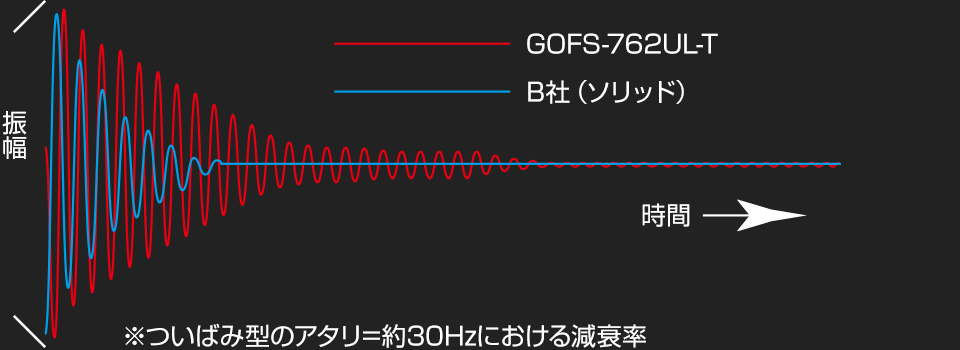
The attenuation rate of GOFS-762UL-T, which had the lowest attenuation rate at 30Hz and the highest attenuation rate of Company B (solid), which was the highest, were made into a time waveform. The slower the convergence of the waveform (lower the attenuation rate), the higher the sensitivity.
And on the golf shaft.

Graphite Reader Sensitive System
Even if the shaft of the golf club is questioned about the flex, torque, kickpoint, and weight, sensitive = sensitivity has not been very important until now. Of course, elements other than sensitivity are also important, but the performance to make use of those characteristics even more, the sensitivity of the shaft was the performance to create a reliable shot. Feel the good or bad of the shot in the palm of your hand, instantly determine the function of the shaft, and feed back to the next shot. Sensitivity is to make it possible. The know-how cultivated in the development of fishing rods is G.S.S. ( It is used as the Graphiteleader Sensitivity System) for high-sensitivity shaft production.

G-Maps
In general, the blanks of fishing rods are made by distributing carbon fibers in 0° (vertical) and 90° (horizontal) in the longitudinal direction, and carbon sheets (prepregs) are laminated according to the required power.
In the graphite leader, by adopting an even more advanced manufacturing method called G-MAPS, we succeeded in creating blanks with increased power and strength. The G-MAPS method is an excellent physical method that can also increase the twisting rigidity by incorporating a multi-layer structure using an ultra-thin carbon prepreg, and placing the fiber angle diagonally in the longitudinal direction on some layers.
Therefore, the blanks of the G-MAPS manufacturing method can be said to be high-tech blanks with performance that could not be achieved by conventional general manufacturing methods of being lightweight but powerful. If you combine it with four-axis cloth and multi-axis fabric, it will be possible to create a blank that can be said to be the ultimate.
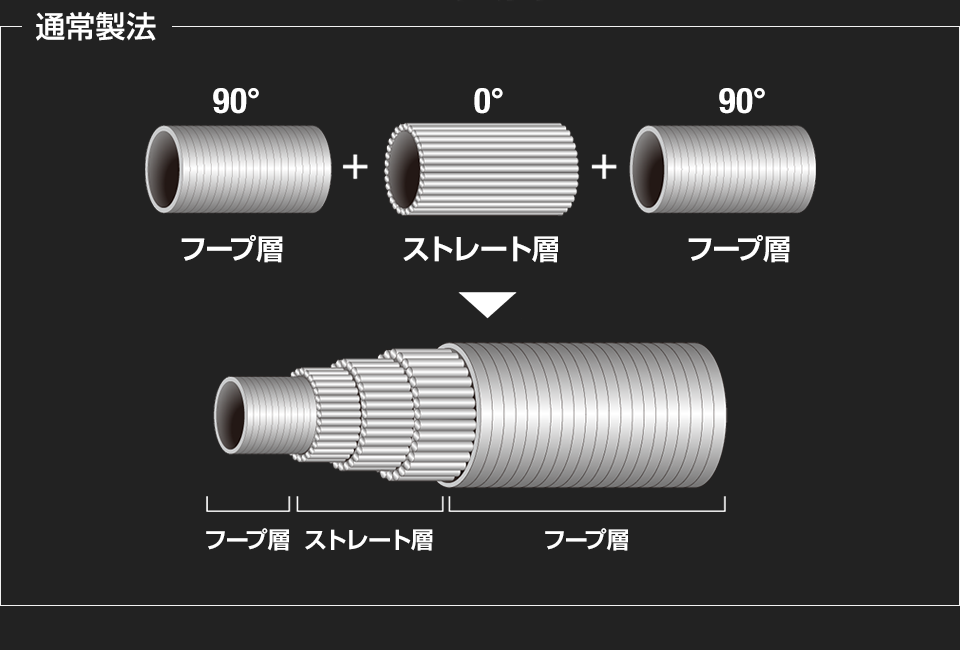
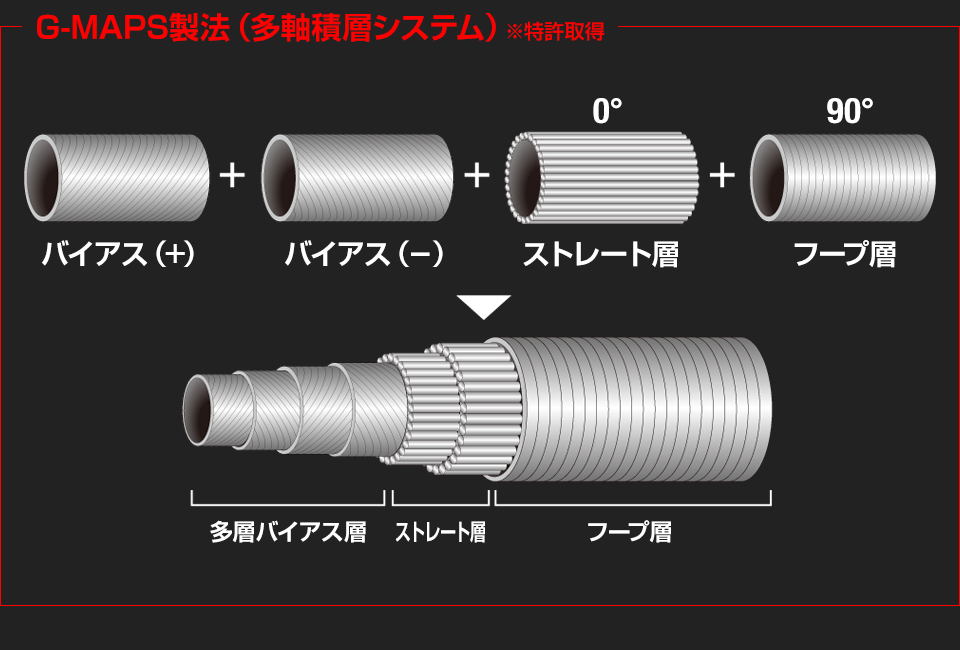
The rod tries to return straight in an instant even if the cross-section on the pipe is deformed by twisting or twisting as shown in the figure. The G-MAPS method has excellent shape resilience, and it has achieved a resilient and spring-like re-return.
※The illustration is an image.
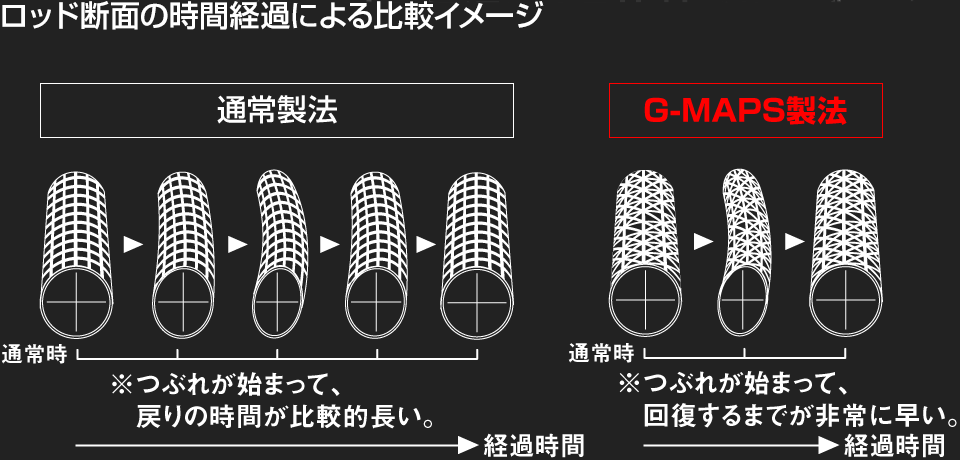

Autoclave technology
The "autoclave manufacturing method" is a special molding method used to produce important parts related to life, such as the main wings of the Boeing 787 and the body of the racing car.
Unlike conventional curing processes and molding methods, using a dedicated curing furnace, it is an epoch-making molding method that can eliminate the bubbles (voids) present between the stacking carbon sheets as much as possible by "degassing" and "further pressurized" in the heating process. It is. High quality, high purity, stable strength, and further weight reduction can be expected.
